Renuka
Renuka, also known as Yellamma, is a Hindu goddess worshipped predominantly in the South Indian states of Karnataka, Tamil Nadu, Telangana, Kerala, Andhra Pradesh and western state of Maharashtra.[3] She is also known as the mother of Parashurama, the sixth avatar of the god Vishnu. She acquired the status of a mother goddess before eventually being associated with the legend of Parashurama.[4]
| Renuka | |
|---|---|
Goddess of the Fallen[1] | |
 | |
| Devanagari | रेणुका |
| Sanskrit transliteration | Rénûka |
| Affiliation | Devi |
| Mount | Lion |
| Region | South India |
| Personal information | |
| Consort | Jamadagni |
| Children | Ṛumaṇvān, Suhotra, Vasu, Viśvāvasu, Parashurama[2] |
Names
Renuka is venerated by a number of different appellations such as Yellamma, Ekvira, Yamai, Ellai Amman, Padmakshi Renuka, and Ellai Amma Mahar, Kannada: ಶ್ರೀ ಯಲ್ಲಮ್ಮ ರೇಣುಕಾ, (Marathi: श्री. रेणुका / येल्लुआई, Tamil: ரேணு/ரேணுகை அம்மன், Telugu: శ్రీ రేణుక/ ఎల్లమ్మ) and is worshipped as the goddess of the fallen in the Hindu pantheon. Her devotees revere her as the "Mother of the universe" or Jagadamba.
Other names for Yellamma include Mariamma, Chaniamma, Gangamma, and Kariyamma.[5]
Legends
Legends about Renuka are mentioned in the Mahabharata, the Harivamsa, and in the Bhagavata Purana.[6]
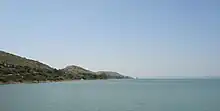
There are four incarnations of Adi parashakti (Kamakshi in Kanchi[7]) is worshipped. Vishalakshi in North Kashi,[8] Renukakshi[9] (Padmakshi) in West Alibag also known as padmakshi renuka of Konkan, Meenakshi[10] in South in Madurai also known as Meena and Bahulakshi[11] in East.
Early life
King Renu (father of Renuka) performed a yajna – a ritual performed to maintain peace and good health. He was blessed with a daughter, who originated from the fire of this yajna. Renuka was a bright and active child and became the most beloved child of her parents.
When she was eight, Agastya, the guru of King Reṇu, advised him to have his daughter married to Jamadagni when she reached maturity. Jamadagni was the son of Ruchika and Satyavati and had obtained the blessings of the gods by performing severe penance. Renuka helped Jamdagni in all of his tasks of performing various rituals and puja. After a while, Renuka was blessed with another daughter called Anjana. Renuka would wake up early in the morning to bathe in the Malaprabha River with complete concentration and devotion. Her devotion was so powerful that she was able to create a pot to hold water made only of sand, one fresh pot every day. She would fill this pot on the bank of the river and would use a snake which was nearby, turning it into a rope-like convolution and placing it on her head, so that it supported the pot. Thus, she brought the water to Jamdagni for his rituals of oblation.
Married life
Renuka gave birth to five sons: Ṛumaṇvān, Suhotra, Vasu, Viśvāvasu, and Rama Bhargava.[12] Rama Bhargava was the youngest and most beloved, gaining the favour of Shiva and Parvati. Rama performed severe penance and was bestowed with an axe (parashu), and was henceforth called as Parashurama (the sixth incarnation of Vishnu).[13] One day, when Renuka went to the river, she saw a king make love to his wives. She was captivated by the sight, as a result of which she lost her concentration and devotion to her husband for a moment. As she was distracted, she lost her power of collecting water in unbaked pots, which she had gotten from her chastity. She lost the water that she had collected. Disappointed by this, she returned to the ashram in worry. Jamadagni had seen these events through his yogic power and was furious when she came back to the ashram.[14]
After being cursed by her husband, Renuka went east and sat in the forest to meditate. In her penance, she met with the saints Eknath[15] and Joginath; and requested them to gain the mercy of her husband. They first consoled her and then instructed her to follow their advice exactly as told. They told her to purify herself, first bathing in a nearby lake, and then to worship a Shivalinga, which they had given to her. Next, she was asked to visit the nearby town and beg for rice from the houses (this ritual, called "Joga Bedodu", is still carried out by women during a particular month in Karnataka/ "Jogawa" in Marathi, "Yellamma Jogu" in Telangana).
After collecting the rice, she was to give half to the saints and cook the remaining half, adding jaggery, partaking of the cooked rice with full devotion. They said that if she performed this ritual for three days, she would be able to visit her husband on the fourth day.
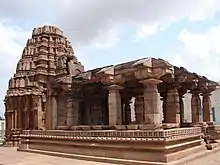
Knowing the anger of Jamadagni, they warned her that she may not be fully pardoned by him and that she would have to experience the most difficult time of her life for a few minutes. "After that," they said, "you will be eternally revered and will be blessed with your husband. You will be worshipped by all the people henceforth." After blessing her thus, they disappeared. Renuka followed their instructions with devotion and worshipped the Shivalinga with reverence. On the fourth day, she went to see her husband.
Decapitation and resurrection
Jamadagni was still furious with Renuka and ordered his elder four sons to kill his wife, but all of them refused to kill their mother. Jamadagni cursed his four sons and reduced them to ashes for disobeying his order. Then, Jamadagni called his fifth son Parashurama, who was meditating on Shiva, and ordered him to behead Renuka. Parashurama immediately obeyed his father's words and beheaded his mother with his axe. Jamadagni was pleased by Parashurama's devotion and obedience towards him.
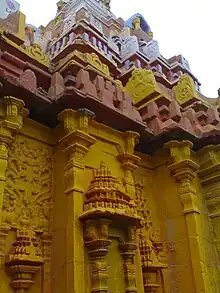
He then offered a boon to Parushurama, who wisely asked for his mother and brothers to be brought back to life. Jamadagni was impressed by Parshuram's pragmatism and brought Renuka and her four sons back to life. Jamadagni felt strong remorse for what he had done to his beloved and compassionate wife. He then vowed not to get angered ever again and gave up krodha forever.
Disappearance
According to a tale, emperor Sahastarva wanted to marry Renuka. When Parashuram was away, Sahastarva killed Jamadagni and his four sons and then Renuka jumped in the pond known as Ramsarover. This lake is today venerated as Renuka lake.[16]
A version among Deori people states that Jamadagni asked his sons to kill Renuka to prove their obedience before bringing her back to life.[17]
Temples and related places

One of the famous temples of Renuka Yellamma Thalli is located at Balkampet in Hyderabad where every year in the Ashadha month Yellamma Kalyanothsavam is celebrated with thousands of pilgrims performing special rituals to get the blessings of Renuka Yellamma Thalli. The Murti of the goddess is 10 feet deeper than the ground level. There is also a well in the Balkampet Yellamma temple complex and some devotees believe that the water in the well heals all ills. Taking a bath here is supposed to purify one of all disorders and skin diseases. This holy water is called 'tirtham'. An Akhand Jyoti is also present in the temple that was lit during the renovation.
Every year, there is a gathering of 200,000 to 600,000 devotees at the Yellamma Gudi temple (Yellamma Temple) in Saundatti.[18][19]
Three other very famous Temples of Renuka Yellamma are located in Mandapaka/Tanuku, West Godavari district, Andhra Pradesh, Bidarahalli, Gadag, and Chandragutti, Shimoga, Karnataka, India. Many devotees from different regions come to the temple in the month of Kartik and revere Renuka-Yellamma. It is believed that after her marriage with the sage Jamadagni, Renuka lived in this place. Renuka used to wake up early in the morning and bathe in the holy Tungabhadra River. With complete concentration and devotion to fill the pot, which she used to prepare out of the sand on the bank of the river and would hold the snake which was there and turn it into a convolution and place it on the head so that it supported the pot. She bought the pot to Jamdagni for the performance of rituals.
There is a famous temple in Kavade Village of Alibag of Renuka Devi named "Padmakshi Renuka Devi", where people also call her "Aai mauli". She is also known as Kali, Bhairavi, Amba, Ekvira. Her sister is known as Jogeshwari. Her mount or Vahan is Vmshatki the animal made of 20 Guna. She is a newly formed Shakti peeth and is one of 108 Shakti peeth. Goddess has been described as having very beautiful charm and glory on her face with a loving nature.
A famous Renuka mata temple over 350 years old is located in the Raja Rayan Dewdi,Charminar, Hyderabad. This super powerful temple is only open for public in navratri. It is said that this goddess fulfils all wishes. Durgaashtami is the most important day when lakhs of devotees visit Bhavani mata to fulfil their wishes.
Another temple Renukambe [Yellamma] is atop a hill in Chandragutti, Soraba Taluk in Shimoga. This temple is an example of ancient architecture and dates back to the Kadamba period. Another temple is in Mahur, Maharashtra, the supposed birthplace of the goddess, which finds mention in Devi Gita, the final chapter of Devi Bhagawatam as, "Matripura in the Sahyadri mountain; here the Devi Renuka dwells".[20]
Amravati city in Maharashtra also has a fairly popular temple of Ekvira Devi along with a very old and esteemed temple of Amba Devi. Both the temples are situated in the same compound and are a very important part of the city's history. It is held with great admiration and belief in the minds of the devotees. People come here with utmost faith and belief that all their wishes will be fulfilled and the difficulties will be eradicated from their lives. The temples have a rich historic and mythological importance. There is the belief that the Ekvira devi temple was built around the year 1660 by the son of Paramhans Shri Janardan Swami Maharaj in memory of his father. Legends say that roughly 500 years ago, Janardan Swami used to live in this region. He was a worshiper of Goddess Amba and used to visit Ambadevi Temple. During those days, a stream used to flow beside the Ambadevi Temple, which is in the temple area. Once this stream was too flooded due to Monsoon and became difficult for Janardan Swami to cross. Goddess Amba saw her devotee in such distress and offered his prayers from the other side of the stream. She came down on Earth in a different human form and an arrow miraculously appeared signifying the presence of the Goddess. This form of Amba Mata in the form of Ekvira Devi and her temple building is at the place where the arrow hit the ground.
It is believed that when Rukmini went to visit the temple, Lord Krishna abducted Devi Rukmini from here and then they got married. People from various cities throng to visit the temples especially during the festival of Navratri. The city of Amravati is also known as Ambanagari, in honour of the goddess.
One of the temples of Renuka Devi is Chandwad in Nasik. The temple was constructed by her highness Maharani Ahilyabai Holkar of Indore. The second place is Matripura in the Sahyadrî mountains.
Another temple of Devi is at Dhamnand-Posare, Taluka Khed, Maharashtra known as "Devi Yalubai".[21]
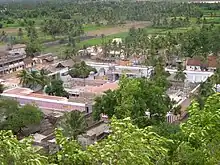
In Tamil Nadu, Renugambal Amman Temple (it is Kuladaivam for Jambu Maharishi (Jamadagini) gotra Vanniyars), Senguntha Muthaliyars and other communities' people tracing their origin in that locality. The temple is situated in Padavedu, Thiruvannamalai District and it is one of the most important Sakthi Sthalas, another temple is located at Manthangal village, Ranipet district, Tamilnadu. The presiding deity here is called Kondi Amman (worshipped by Pokanati Reddys settled from the Carnatic-Andhra regions).[22]
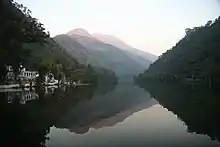
Renuka Lake in the Renuka Sanctuary in Himachal Pradesh is named after the goddess. According to one legend, the Haihaya King Sahasrarjuna (Kartavirya Arjuna) wanted the Kamadhenu cow from Jamadagni and Renuka. So for this he killed Jamadagni, and Renuka jumped into pond here along with Jamadagni at Renuka, Sirmour (Himachal Pradesh).[23][16]
Another famous temple for Renukambal is situated in Serampattu Village near Cheyyar in the Tiruvannamalai district. Thousands of people gather here during the Pongal festival. Another powerful temple of Renuka Parameshwari is located in Tiruchampalli near Sembanarkoil in the Nagapattinam district of Tamil Nadu.
One more temple of Ellamma is situated at the village of Ragupathi Naicken Palayam of Erode, Tamil Nadu. Ragupathi Naicken Palayam can be reached from Erode – Poondurai Road as well as Erode – Vellode Road. Although it is unclear when the temple was constructed, it is understood from the inscription placed at the temple that the temple was renovated by the late Mr. Duraisamy Naicker in 1923. He is said to belong to the community of Banajiga (or Balija) of Lingayat Society which has origin in Karnataka but settled in Tamilnadu in the 19th century. The temple is maintained by people of the Banajiga community now. Maha Shivratri in the month of Maasi and the full moon day of Karthigai are celebrated by the Banajigas in this temple.
Goddess Renuka and Lord Jamdagni Muni are worshipped in villages around Yamuna river in Rawain valley of Uttarkashi district in Uttaranchal. Many ancient temples in the region are dedicated to the divine couple – the most famous being the Jamadagni temple at Thaan village near the bank of yamuna and Renuka temples in the uphill village of Devadokhri, Banchangaon, and Sarnaul. The region has an age-old tradition of celebrations in commemoration of the local deities, and managing the temple affairs and customs. The priesthood is claimed on the basis of ancestry and merit both, and mainly held by Khanduri, Semwal, and Dimri Brahmins of Uttaranchal. The week-long annual festivities in the month of June are main attraction for devotees around the region.
Further reading
- The Village Gods of South India (London, 1921) by H. Whitehead
- Yellamma: A Goddess of South India (1995) by Channappa Uttangi
- Given to the Goddess: South Indian Devadasis and the Sexuality of Religion (2004) by Lucinda Ramberg
- Melissa Hope Ditmore, ed. (2006). Encyclopedia of Prostitution and Sex Work: A-N. Vol. 1. Greenwood Publishing Group. pp. 103–104. ISBN 9780313329685.
References
- Thallam, Sarada (6 January 2017). Rajam Krishnan and Indian Feminist Hermeneutics. Cambridge Scholars. ISBN 9781443864916.
- "Story of Jamadagni". 28 January 2019.
- "Sri Renuka Amman Parameswari". Archived from the original on 18 May 2015. Retrieved 29 April 2015.
- Varadpande, Manohar Laxman (2009). Mythology of Vishnu and His Incarnations. Gyan Publishing House. ISBN 978-81-212-1016-4.
- Nagendra Singh (2006). Global Encyclopaedia of the South Indian Dalit's Ethnography. Vol. 1. Global Vision. p. 110. ISBN 9788182201675.
- Pattanaik, Devdutt (11 July 2014). Myth = Mithya: Decoding Hindu Mythology. Penguin UK. ISBN 978-81-8475-021-8.
- Harshananda, Swami (2012). Hindu Pilgrimage Centres (second ed.). Bangalore: Ramakrishna Math. p. 61. ISBN 978-81-7907-053-6.
- Bangala Bhasar Abhidhaan [Dictioanary of the Bengali Language], Kolkata: Shishu Sahitya Samsad, Volume 2, p.1600. (ed. 1988)
- "Sri Renuka Amman Parameswari". Archived from the original on 18 May 2015. Retrieved 29 April 2015.
- Harman, William P. (1992). The Sacred Marriage of a Hindu Goddess. Motilal Banarsidass. p. 24. ISBN 978-81-208-0810-2.
- পাইন, সুগত (2021). নানারূপে সতীঅঙ্গ. p. 27.
- www.wisdomlib.org (28 January 2019). "Story of Jamadagni". www.wisdomlib.org. Retrieved 25 September 2022.
- Shah, Sunil A. (May 2010). "ચિરંજીવી, શૌર્યતા, જ્ઞાનના સંગમ સમાન ભગવાન પરશુરામ" [Ciran̄jīvī, śauryatā, jñānanā saṅgam samān Bhagavān Paraśurām]. Divya Bhaskar (in Gujarati). Retrieved 29 April 2015.
- Pattanaik, Devdutt (24 April 2003). Indian Mythology: Tales, Symbols, and Rituals from the Heart of the Subcontinent. Simon and Schuster. ISBN 978-1-59477-558-1.
- Chugh, Lalit (23 May 2017). Karnataka's Rich Heritage – Temple Sculptures & Dancing Apsaras: An Amalgam of Hindu Mythology, Natyasastra and Silpasastra. Notion Press. ISBN 978-1-947137-36-3.
- Yadav, Krishna (2010). The Royal Bargain. Har Anand. p. 119. ISBN 978-81-241-1530-5. Retrieved 23 April 2023.
- Behera, M.C. (1998). Pilgrim Centre Parashuram Kund: Articulation of Indian Society, Culture, and Economic Dimension. Commonwealth Publishers. p. 38. ISBN 978-81-7169-503-4.
- "Six lakh devotees throng Yellamma temple". The Hindu. 12 January 2017. ISSN 0971-751X. Retrieved 30 May 2021.
- "Lakhs visit Yellamma temple on Bharat Hunnime fair". Deccan Herald. 30 January 2010. Retrieved 30 May 2021.
- "Chapter XXXVIII: The Vow and the Sacred Places of the Devi". The Devi Gita [Song of the Goddess]. Excerpt from the Srimad Devi Bhagawatam. Translated by Swami Vijnanananda (Hari Prasanna Chatterji). 1921.
O King of Mountains! Still, I am now telling something out of My affection to My Bhaktas. Hear.
- "Devi Yalubai". Verses: 3-10. Archived from the original on 12 October 2013. Retrieved 3 March 2013.
{{cite web}}: CS1 maint: bot: original URL status unknown (link) - "Arulmigu Renugambal Amman Temple, A.K. Padavedu". Archived from the original on 8 January 2014.
- Kohli, M. S. (2002). Mountains of India Tourism, Adventure, and Pilgrimage. Indus Publishing. p. 303. ISBN 978-81-7387-135-1.
External links
 Media related to Renuka at Wikimedia Commons
Media related to Renuka at Wikimedia Commons
